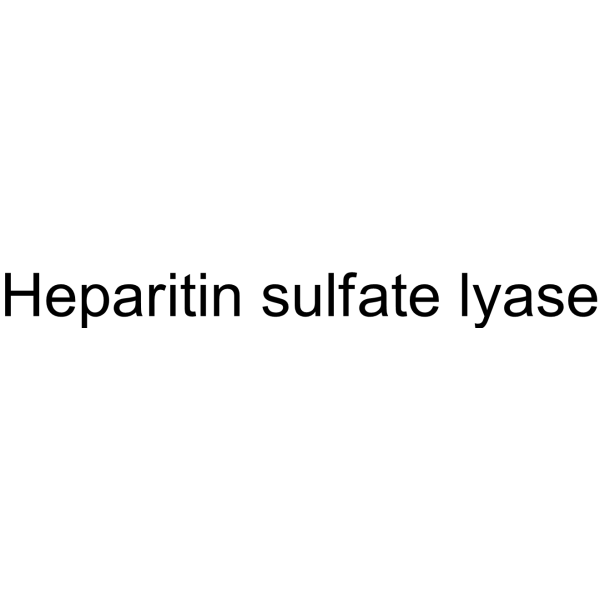Heparitin sulfate lyase

Heparitin sulfate lyase structure
|
Common Name | Heparitin sulfate lyase | ||
|---|---|---|---|---|
| CAS Number | 37290-86-1 | Molecular Weight | N/A | |
| Density | N/A | Boiling Point | N/A | |
| Molecular Formula | N/A | Melting Point | N/A | |
| MSDS | USA | Flash Point | N/A | |
|
Role of glycocalyx in flow-induced production of nitric oxide and reactive oxygen species.
Free Radic. Biol. Med. 47(5) , 600-7, (2009) Although the glycocalyx has been implicated in wall shear stress (WSS) mechanotransduction, the role of glycocalyx components in nitric oxide (NO) and reactive oxygen species (ROS) production remains unclear. Here, we tested the hypothesis that glycocalyx is ... |
|
|
The heparin-binding domain of HB-EGF mediates localization to sites of cell-cell contact and prevents HB-EGF proteolytic release.
J. Cell Biol. 123 , 2308-18, (2010) Heparin-binding EGF-like growth factor (HB-EGF) is a ligand for EGF receptor (EGFR) and possesses the ability to signal in juxtacrine, autocrine and/or paracrine mode, with these alternatives being governed by the degree of proteolytic release of the ligand. ... |
|
|
The signal peptide of Staphylococcus aureus panton valentine leukocidin LukS component mediates increased adhesion to heparan sulfates.
PLoS ONE 4(4) , e5042, (2009) Staphylococcus aureus necrotizing pneumonia is a severe disease caused by S. aureus strains carrying the Panton Valentine leukocidin (PVL) genes (lukS-PV & lukF-PV) encoded on various bacteriophages (such as phiSLT). Clinical PVL+ strains isolated from necrot... |
|
|
The HPV16 and MusPV1 papillomaviruses initially interact with distinct host components on the basement membrane.
Virology 481 , 79-94, (2015) To understand and compare the mechanisms of murine and human PV infection, we examined pseudovirion binding and infection of the newly described MusPV1 using the murine cervicovaginal challenge model. These analyses revealed primary tissue interactions distin... |
|
|
Shear stress modulation of smooth muscle cell marker genes in 2-D and 3-D depends on mechanotransduction by heparan sulfate proteoglycans and ERK1/2.
PLoS ONE 5(8) , e12196, (2010) During vascular injury, vascular smooth muscle cells (SMCs) and fibroblasts/myofibroblasts (FBs/MFBs) are exposed to altered luminal blood flow or transmural interstitial flow. We investigate the effects of these two types of fluid flows on the phenotypes of ... |
|
|
Heparin strongly induces soluble fms-like tyrosine kinase 1 release in vivo and in vitro--brief report.
Arterioscler. Thromb. Vasc. Biol. 31(12) , 2972-4, (2011) Soluble fms-like tyrosine kinase 1 (sFlt1) is involved in the pathophysiology of preeclampsia and coronary artery disease. Because sFlt1 has a heparin-binding site, we investigated whether or not heparin releases sFlt1 from the extracellular matrix.We measure... |
|
|
Syndecans reside in sphingomyelin-enriched low-density fractions of the plasma membrane isolated from a parathyroid cell line.
PLoS ONE 7(3) , e32351, (2012) Heparan sulfate proteoglycans (HSPGs) are one of the basic constituents of plasma membranes. Specific molecular interactions between HSPGs and a number of extracellular ligands have been reported. Mechanisms involved in controlling the localization and abunda... |
|
|
Stiffness and heterogeneity of the pulmonary endothelial glycocalyx measured by atomic force microscopy.
Am. J. Physiol. Lung Cell. Mol. Physiol. 301(3) , L353-60, (2011) The mechanical properties of endothelial glycocalyx were studied using atomic force microscopy with a silica bead (diameter ∼18 μm) serving as an indenter. Even at indentations of several hundred nanometers, the bead exerted very low compressive pressures on ... |
|
|
Intraarticular injection of heparin-binding insulin-like growth factor 1 sustains delivery of insulin-like growth factor 1 to cartilage through binding to chondroitin sulfate.
Arthritis Rheum. 62(12) , 3686-94, (2010) Insulin-like growth factor 1 (IGF-1) stimulates cartilage repair but is not a practical therapy due to its short half-life. We have previously modified IGF-1 by adding a heparin-binding domain and have shown that this fusion protein (HB-IGF-1) stimulates sust... |
|
|
Heparan sulfate acts as a bone morphogenetic protein coreceptor by facilitating ligand-induced receptor hetero-oligomerization.
Mol. Biol. Cell 21(22) , 4028-41, (2010) Cell surface heparan sulfate (HS) not only binds several major classes of growth factors but also sometimes potentiates their activities--an effect usually termed "coreception." A view that coreception is due to the stabilization of growth factor-receptor int... |